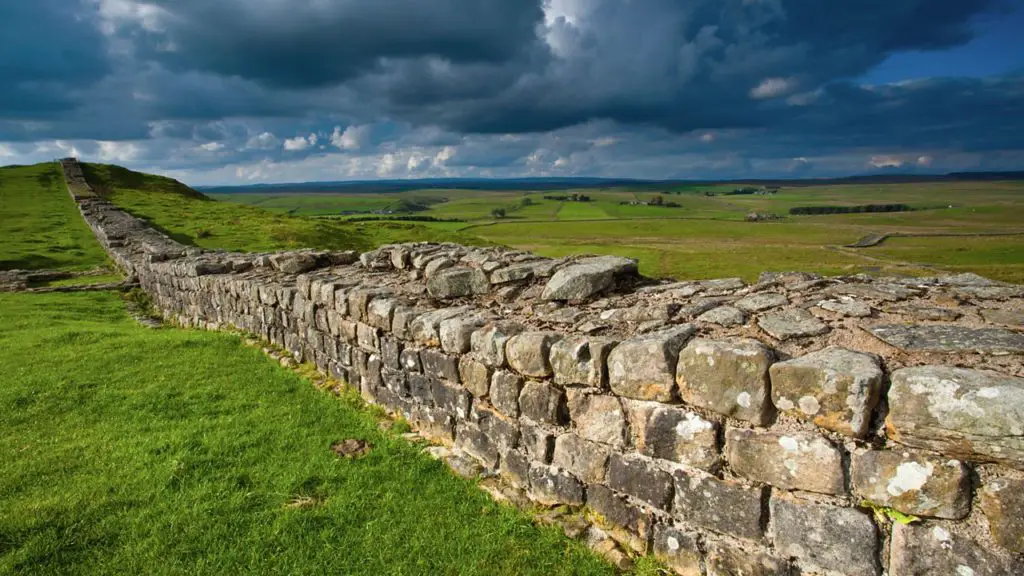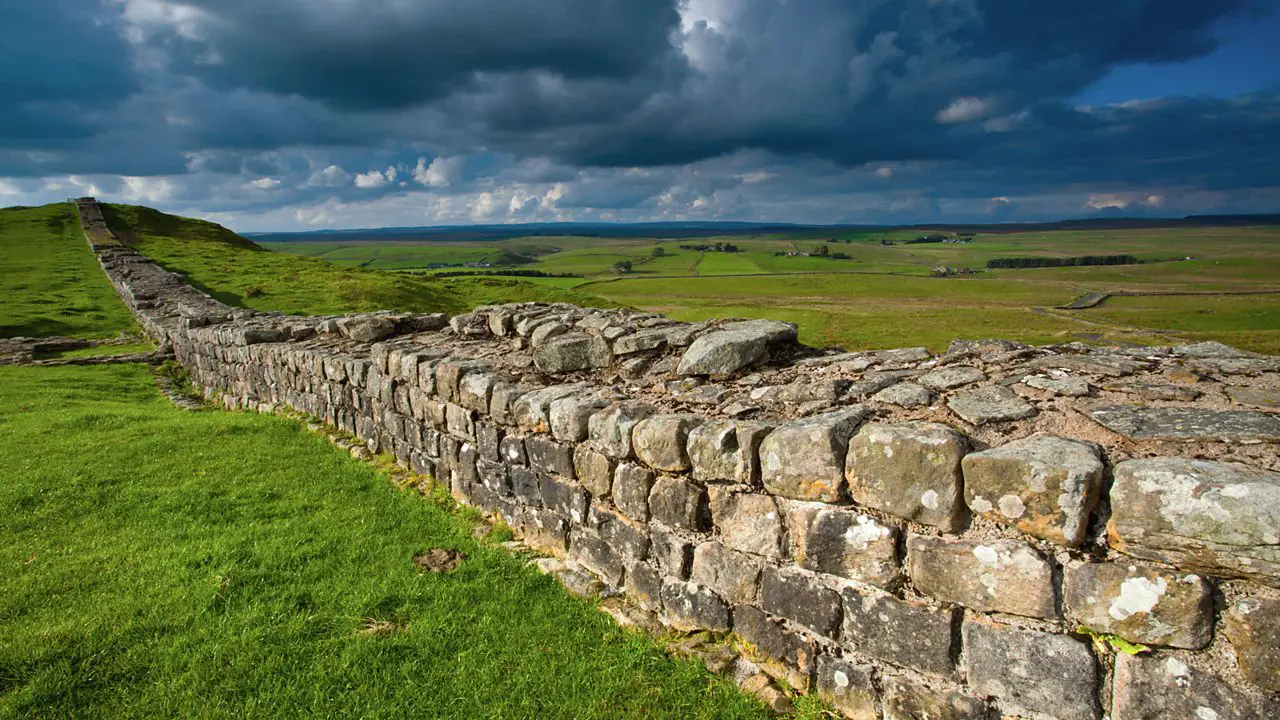After almost 400 years, Roman rule in Britain finally came to an end. However, just as the start of Roman governance in the island was a gradual process, the end likewise took place gradually.
First of all, it is important to acknowledge that it is not perfectly understood, and new discoveries are still being made which clarify how it took place. With that in mind, let us consider what we do know.
The Beginning of the End
 The very start of the downfall of the Roman Empire in Britain can really be pinpointed to the year 383. In this year, a military commander (and possible governor of Britain) named Magnus Maximus was declared emperor by his soldiers.
The very start of the downfall of the Roman Empire in Britain can really be pinpointed to the year 383. In this year, a military commander (and possible governor of Britain) named Magnus Maximus was declared emperor by his soldiers.
This man had grand intentions, so he almost immediately set out on a conquest of Gaul. He gathered the armies of Britain and departed from the shores of the island. Once in Gaul, he swiftly, and with very little bloodshed, defeated the legitimate emperor of the West, Gratian, and came to dominate the western half of the Empire (along with the young Valentinian).
By all accounts, Maximus was a popular and effective leader. He appears to have rapidly built up a powerful governance over an enormous area. Yet ironically, by this action of usurping the throne and taking over control of Gaul and much of the rest of the western half of the Empire from Gratian, he severely and irreparably damaged Roman control of Britain.
It is known that Maximus gathered a very large army when he initially invaded Gaul in 383, and again when he fought against the eastern emperor, Theodosius, five years later. Gildas, writing some two centuries later, claims that this usurper had deprived Britain of its Roman forces.
The archaeology and other records do not support the notion that all of the Roman forces were withdrawn from Britain in the 380s. However, what is clear is that many troops were withdrawn, especially from the area that is now Wales.
In fact, it is generally held that Roman military presence entirely ceased from Wales from that point on. In addition, there is a great lack of evidence of Roman presence in much of the north of Britain around this time as well.
Thus, it appears that while Magnus Maximus did not completely strip Britain of its Roman forces, he did withdraw a considerable number of them, essentially abandoning Wales and some of the outer regions.
For a number of years after this, Roman rule in the island limped on. The Romans still formerly had control of Britain, and on a number of occasions they engaged in campaigns to protect the border regions. But, nonetheless, it can definitely be said that the grip of the Roman Empire was waning by this period.
The Final Blow
In the early fifth century, a number of usurpers arose in Britain. The first two quickly fell, but the next one, known to historians as Constantine III, had much more success. In the year 407, he was proclaimed emperor by his troops, and he set out to seize control of Gaul just as Magnus Maximus had done years before.
The Roman forces in Gaul were happy to accept Constantine as their new emperor. The usurper effectively fought off the Vandals and secured the Rhine. He then engaged in battle against the forces of the legitimate Western Emperor, Honorius. With some difficulty, Constantine eventually managed to subdue Honorius. By the year 409, Constantine III was recognised as the official Emperor of the West, along with Honorius as his co-emperor.
The initiation of this usurpation of the western half of the Empire had enormous repercussions for Roman Britain, just as in the time of Maximus. When Constantine left Britain to seize control of Gaul, he obviously took with him many Roman troops. It appears, from an examination of the archaeological record along with written evidence, that the vast majority of the Roman forces in Britain departed for Gaul at this time.
However, the island was still, theoretically, in the hands of the Roman Empire. It was certainly still part of Constantine’s domain, even if there were virtually no troops there. However, that changed in the year 409, the same year that the usurper was recognised by Honorius as a legitimate emperor.
Roman historian Zosimus informs us that in the year 409, the native Britons expelled the Roman administration from the island. So now, with almost no troops and no administration, Roman power over Britain really had come to an end. It can truly be said that 409 marks the year when Britain was no longer part of the Roman Empire.
What Didn’t End
 However, despite the fact that Britain was now out of the Empire, it is not as if the island suddenly returned to its native ways. Roman culture had been present in Britain for almost four centuries, so it would be remarkable if it suddenly disappeared.
However, despite the fact that Britain was now out of the Empire, it is not as if the island suddenly returned to its native ways. Roman culture had been present in Britain for almost four centuries, so it would be remarkable if it suddenly disappeared.
In reality, the evidence is clear that many elements brought to Britain by the Romans stayed there after they left. For example, the sixth century writer Gildas refers to a certain Ambrosius Aurelianus as a Roman, yet he lived many years after Britain left the Roman Empire.
In addition, archaeological discoveries have revealed that the Roman form of administration continued, at least in some parts of the island, for at least 100 years after the departure of the Romans. An inscribed stone discovered in north Wales has some particularly enlightening information on it.
Dating back to the early sixth century, the inscription refers to a certain Cantiorix and mentions that he was the cousin of a certain ‘Maglos the magistrate’, using the Latin ‘magistratus’. This has been taken by a number of scholars as evidence that a Roman style of administration still existed in this part of Wales by the time the inscription was created.
Another inscription, also of the sixth century, is the Vortiporius Stone. This is a memorial stone for a man named Voteporigis (considered by some to be identical to Gildas’ Vortiporius). On the inscription, he is given the title ‘Protictoris’, a form of the Latin ‘Protector’. Like ‘magistratus’, this was a Roman title.
Both of these inscriptions indicate that at least some form of Roman governance continued in the island at least until the sixth century. This evidence, combined with Gildas’ words concerning Ambrosius, gives us good reason to believe that the year 409 did not suddenly take away all Roman influence from the island. While the natives were outside the control of the Empire, they seemingly still governed themselves based on the system that had existed in the island for several centuries.
Nonetheless, it also quickly fractured into many independent kingdoms, thus combining the Roman-style administration with the general political picture of pre-Roman Britain.
Honorius’s Letter
As the reader may note, the year given for the end of Roman rule in Britain is 409. However, there is a different (albeit very similar) date given by many other modern sources for the end of Roman Britain. This year is 410. What is the basis for claiming that this was the year which marked the end of Roman Britain, and why is this not valid?
Firstly, the basis for this year being given is that it was the year in which Emperor Honorius supposedly wrote a letter to the Britons to tell them that the Romans could no longer defend them, so they had to fend for themselves. On this basis, many scholars hold this year to mark the true end of Roman rulership of Britain.
However, there are a number of problems with this conclusion. Firstly, it is possible that the letter was not actually sent to Britain. Rather, it may be that it was actually sent to a similarly named region in southern Italy – namely, Bruttium.
According to this theory, the word that the Roman writer who mentioned the letter (Zosimus) actually meant to write was ‘Brettia’ (in reference to Bruttium), rather than ‘Brettania’ (in reference to Britain).
In support of this is the fact that the rest of the passage concerns events in northern Italy. Alaric, king of the Visigoths, had recently appointed a puppet emperor in opposition to Honorius, and he was attacking cities that did not accept the new emperor. For the past few years, Alaric had been tormenting northern Italy and had marched at least as far south as Rome twice already.
On this basis, supporters of the Bruttium theory say that it would be more logical for Honorius to have sent a letter to Bruttium to the effect that he could no longer defend them, rather than sending this letter to Britain. Or at least, it would appear more logical for this to be the case given the context of the mention of the letter in Zosimus’ account, just after describing Alaric attacking cities in Italy that were not recognising his puppet emperor.
So, it is quite possible that Honorius did not actually tell Britain in 410 that the Romans could no longer defend them. However, even if this Bruttium theory is wrong and the letter really was sent to Britain, the year 410 still cannot be used to mark the end of Roman rulership in Britain.
To see why, consider another letter from this period. This is the appeal to Agitius, sent from the Britons to ask the Romans to save them from the attacks of barbarians. The Romans did not do as the Britons asked.
This appeal is generally dated to the year 447. It is likely that this appeal actually took place much earlier, and the evidence for this can be seen in the article ‘The Saxon Invasion of Britain’. But, nonetheless, the majority of scholars hold that it was sent in about 447.
With this in mind, do the majority of scholars consider 447 to mark the end of the Roman Empire in Britain? No, of course not. The Romans were already out of the island and no longer had any control over it. The fact that they were now presented with an appeal for help, which they refused, does not in any way mark the end of their rulership over the island, for that had already come to an end.
It is the same with the letter sent by Honorius, refusing to offer assistance to the inhabitants of Britain (if we suppose that it really was sent to Britain). As we know from Zosimus (the same writer who documented Honorius’s letter, no less), the Britons had already expelled the Roman administration from the island the previous year, in 409.
This being the case, the situation in 410 was exactly the same as that in 447 (if we accept the traditional date for the appeal to Agitius). The Romans had already lost control of the island, so their refusing to return and help does not mark the end of their control of the island.
Thus, regardless of whether or not Honorius sent his letter to Britain, the Romans had already lost control of the island. Roman Britain came to an end in 409, regardless of any requests for help after that point.
Final Thoughts
We can see that the downfall of the Roman Empire in Britain was, quite ironically, primarily a result of efforts of expansion. First, Magnus Maximus withdrew many troops to seize control of the Western Roman Empire, and Constantine III did effectively the same thing in 407.
As a result of these withdrawals, Roman control over Britain fell into disrepair, until finally the natives expelled the Roman administration in 409. Nonetheless, the general Roman form of governance that existed over the island continued in one form or another for at least another century, albeit within fractured kingdoms that had quickly sprung up from the rubble of Roman Britain.



Caleb Howells, thank you for a clear and persuasively written blog post.